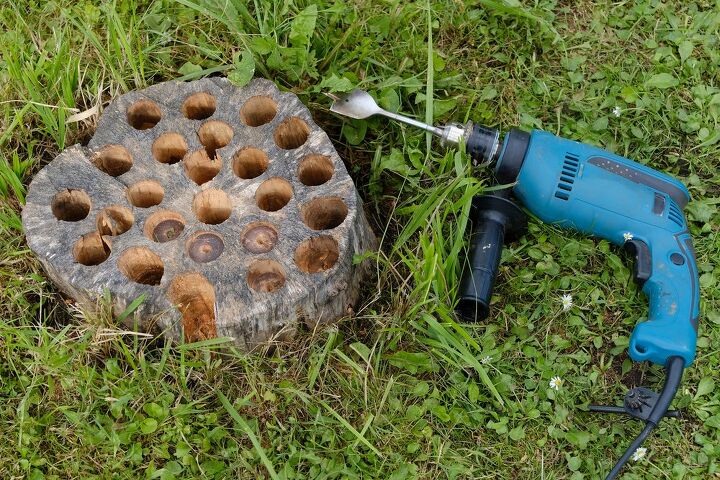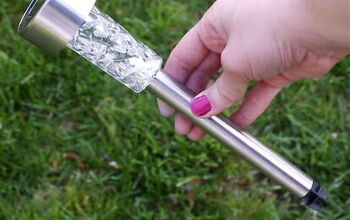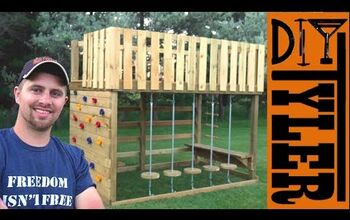How to Kill a Tree Stump in 7 Different Ways

By Marilyn Syarto
Removing a tree from your yard involves two steps: cutting down the tree, then getting rid of the tree stump. Both steps can cost you money because they are two different processes. But luckily, you can learn how to kill a tree stump yourself without having to hire a tree removal service.
You can always just leave the stump to decay over time—but it’ll take lots of time. It usually takes three to seven years for a tree stump to naturally decay. But if the stump is an eyesore, a tripping hazard, or a condo for termites or carpenter ants, our guide shows you other ways to get the job done more quickly so you can avoid potential issues. Stumps can also harbor root disease.
Take note that a freshly-cut tree stump is much more difficult to remove than a rotted one. That's why, in this guide, we provide you with several methods for accelerating the rotting process to help remove a tree stump along with the traditional—and labor-intensive—method of digging a tree stump out yourself.
Uses for Tree Stumps
Photo via Shutterstock
How to Kill a Tree Stump with Epsom Salt or Rock Salt
No matter what natural method you use to kill a tree stump, it will take a few months for it to take effect. But if the stump is not a problem in the yard, this could be the best solution.
Although Epsom salt is generally beneficial for plants, a large amount of this mineral is lethal to a tree stump and will kill it and its roots. Rock salt has the same effect on a tree stump. This method should take eight to 10 weeks to kill the stump, depending on its size.
Tools and Materials Needed:
- Protective eye equipment
- Protective gloves and clothing
- Epsom salt or rock salt
- Drill and spade bit
- Heavy-duty tape or thick, dark plastic tarp
- Heavy rocks or sod staples
- Shovel
Step 1: Drill Holes
Before you get started, put on protective eye equipment, gloves, and clothing. Drill as many holes as you can into the surface of the tree stump. Holes should be at least ½ inch in diameter and eight inches deep (taller stumps will need deeper holes).
Step 2: Fill the Holes
Fill every hole to the top with the salt of your choice.
Step 3: Plug the Holes
Plug the holes with sticky tape or cover the stump with a thick dark plastic tarp that won’t let rain or sun through. You need to make sure the salt stays in the holes and doesn’t wash or blow out. If using a tarp, secure it around the stump with heavy rocks or sod staples.
Step 4: Check Back in a Few Months
This method takes about four to six months to kill the stump. Check under the tape or tarp and you will see the stump soften as it rots. Wait until you can then pull the stump apart and dig it up with a shovel and dispose of it.
Use a Careful Pour
How to Kill a Tree Stump with Darkness
If you have time to spare, this is by far the easiest, safest way to kill a tree stump. Keeping sunlight and rain out of the stump will suffocate it and let it die. However, this is a long process—it takes potentially six months before you can remove the dead pieces of the stump. In addition, the taller the stump, the longer this process will take. This method is best for smaller stumps that are close to the ground.
Tools and Materials Needed:
- Light-resistant dark, heavy plastic tarp or trash bag
- Sod staples or heavy rocks
- Shovel
- Topsoil
Step 1: Lay Material
Make sure the material adequately covers the entire stump. You don’t want the piece of plastic to be small enough so that water and sunlight reach under the corners to nourish parts of the stump.
Step 2: Secure the Material
Use sod staples or heavy rocks to make sure the plastic stays securely down.
Step 3: Check Back
Peek under the plastic after about six months to see if this method has rotted the stump (it will be soft and dark). If so, remove the stump with a shovel, and cover the area with topsoil.
How to Kill a Tree Stump with Copper Nails
Using copper nails to kill a tree stump is one of those controversial topics; some people believe it’s a myth while others swear by it. Try it out if you are working with a smaller-size stump, and it can’t hurt anything if it doesn’t work. Just keep in mind that it will take quite a while to kill off the stump.
Tools and Materials Needed:
- Package of copper nails/spikes
- Hammer
- Soil
Step 1: Hammer Spikes
Hammer in copper nails or spikes around the sides of the stump, spacing them an inch apart and at an angle pointing down to the ground.
Step 2: Cover Stump With Soil
Make sure all the nails are covered with soil. This oxidizes the nails to further the process of killing the stump. When the stump is dead or ready to be removed with an ax, first remove the nails for safety.
How to Kill a Tree Stump with Chemicals
The fastest way to remove a tree stump, besides calling a tree service, is to kill it with chemicals. Most chemicals for stump removal are granular which is easier to apply into the holes of a stump, though there are liquid types, too. Liquid removal products may evaporate quickly, according to TreeRemoval.com, a resource of tree removal companies in the U.S., so check the reviews for whatever brand you’d like to use. According to TreeRemoval.com, here are three top choices for tree stump chemical removers:
- Bonide Stump-Out
- Spectracide (comes in fine granules or liquid)
- Tordon RTU (not for use in New York or California)
Here are the basic steps for killing a tree stump with chemicals, but be sure to follow the directions on the label.
Wait for the Stump to Dry
Tools and Materials Needed:
- Protective eye equipment
- Protective gloves and clothing
- Stump removal chemical
- Drill and ⅜-inch bit
- Water
- Ax
Step 1: Drill Holes
Before you get started, make sure you’re wearing protective eye equipment, gloves, and clothing. Drill holes in the tree stump; the taller the stump, the longer the holes should be. Holes should be at least ⅜ inch in diameter.
Step 2: Fill Holes
Pour the stump removal chemical into the holes per the package’s directions. Most of the time, you will add water into the holes after you pour in the chemicals, but follow the product’s directions so you don’t overly dilute the chemicals.
Step 3: Cover the Stump and Wait
The chemicals will be active for a few weeks. Protect children and animals by covering the stump with a tarp held down by scrap wood or heavy rocks. Wait the prescribed amount of time until the stump begins to rot.
Step 4: Chop Apart
With an ax, chop the remaining and rotted tree stump for final removal and dispose.
Avoid Bleach
Photo via Shutterstock
How to Dig Out a Tree Stump
Killing a tree stump by removing it takes a lot of hard physical labor, which is why many people hire a tree service to do this dirty job. But, if you’re up for the serious workout removing a tree stump will give you, then you have three choices: dig it up, grind it down, or burn it out.
Digging out a stump is best done with a smaller tree trunk. That’s because the larger the stump, the thicker the roots, which will likely take more than a chainsaw to cut through.
Tools and Materials Needed:
- Protective eye equipment
- Protective gloves and clothing
- Shovel(s)
- Chainsaw or hatchet
- Handsaw
- Clippers
- Loppers
- Topsoil or mulch
Step 1: Dig Around the Stump
Put on protective eye equipment, gloves, and clothing. Use a shovel to dig around the stump as far down as you possibly can. You will encounter roots that you’ll need to cut along the way.
Step 2: Cut the Roots
Cut larger roots with a chainsaw or hatchet. Smaller roots can be cut with clippers and loppers.
Step 3: Lift the Stump
Once as many of the roots are cut that can free the stump, lift it out of its hole.
Step 4: Fill the Hole
Backfill the hole with dirt, topsoil, or mulch.
Photo via J.a6812527
How to Grind Down a Tree Stump
Hiring a tree service can cost you hundreds of dollars to grind the stump. Luckily, you can rent equipment on your own for less than half the cost to do the same job. It will, however, take you multiple hours depending on the size of the tree stump. (Stump grinders can also get rid of large bushes, too.)
Tools and Materials Needed:
- Protective eye equipment
- Protective gloves and clothing
- Chainsaw
- Shovel
- Stump grinder
- Topsoil or mulch
Step 1: Trim the Stump
Put on protective eye equipment, gloves, and clothing. Use a chainsaw to cut down the stump so it’s as short as possible.
Step 2: Remove Rocks
Use a shovel to dig around the stump to remove rocks that are embedded into the ground around the tree.
Step 3: Use the Cutter Blade
Begin to chip away at the stump and the surrounding roots using the stump grinder machine's cutter blade. You will create sawdust around the stump in the process.
Step 4: Spread Dirt Over Hole
Cover the area with topsoil or mulch.
How to Burn Out a Tree Stump
Burning a tree stump will definitely weaken and kill it. But because of the safety issues, using fire to kill a tree stump should be your last-resort option and reserved only for a large stump where other methods may fail. The fire needs to be slow and controlled, which may not even be a possibility if you live in a very dry climate.
Before you entertain the thought of burning down a stump, know the type of tree you want to burn. Most tree stumps can burn safely, but some species release toxins when they are set on fire. If your stump is an oleander, Mexican elder, or a species with the word “poison” in it as part of its name, avoid burning it down, warns Mr. Tree Services, a tree removal service in Portland, Oregon.
Tools and Materials Needed:
- Protective eye equipment
- Protective gloves and clothing
- Drill and 2-inch spade bit
- Rake
- Chicken wire (optional, but highly recommended)
- Kerosene
- Kindling wood
- Matches
- Shovel
Step 1: Call Your Town Hall or Fire Department
Find out if it is legal in your town to burn a tree stump. Some towns will fine you because it is illegal according to local laws and ordinances. Or, you may need to get permission from the town. If it is legal, proceed to Step 2.
Step 2: Drill Holes in the Stump
Put on protective eye equipment, gloves, and clothing. Drill numerous holes into the top of the stump. Holes should be eight to ten inches deep, two inches in diameter, and one inch apart. The taller the stump, the longer the holes should go down.
Step 3: Remove Leaves
Rake away leaves or weeds close to the tree stump base, which can catch fire. To ensure that no leaves fly onto the fire to fuel it, encase the smoldering stump in chicken wire. The wire will also protect anyone from getting too close, including animals.
Step 4: Pour in Kerosene
Fill the holes with kerosene.
Avoid Using Gasoline!
Step 5: Build a Mound of Kindling
Lay a mound of kindling wood over the top of the stump.
Step 6: Light the Fire
Light the kindling mound with a match.
Step 7: Monitor the Fire
Keep watch of the fire until it is finished burning. This can take about six hours or so. Do not leave it overnight; start this process in the morning so you can keep an eye on the project in the daylight.
Step 8: Dig Away Burnt Pieces
Once the fire is out and the wood is cool to the touch, dig away the burnt pieces of the stump. Smash down any high spots; it will turn into ash at the base of the stump.
Have you killed a pesky tree stump? Let us know how you did it by sharing your tips and tricks below.


























Frequently asked questions
Have a question about this project?